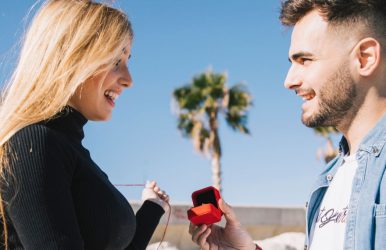What Are The Best Places To Plan A Destination Proposal In The World?
BY Sibashree Sep 18, 2025
A proposal can be a very dramatic event. And it deserves to be: this is a grand, life-defining gesture, and, if you’re the one posing the question, you’ll want the moment to be as magical as possible. Perhaps the most significant factor of all is the setting. While a good solitaire engagement ring is a key consideration, it’s your surroundings that you’ll remember when you reflect on the moment, years from now. The good news is that the world is filled with inspiring places. Many of which will provide a sense of grandeur that you find extremely helpful. Let’s run through some of the best of them. What Are The Best Places To Plan A Destination Proposal? Know The Classical Locations And The Hidden Gems Do you remember the dreamy Ramona Agruma and Rebel Wilson proposal at Disneyland? José Bastón also proposed to Eto va Longoria during a vacation in Dubai. And the list continues… A destination proposal beautifully blends the leisure activities of a vacation with romance. Do you also want to plan an unforgettable marriage proposal for the love of your life? Check out these best places to plan a destination proposal. 1. United States, Timeless Locations You don’t have to look any further than the United States if it’s inspiration you’re looking for. There are options to suit couples of every taste and inclination. Do you want an urban proposal? Perhaps as part of a visit to a major city? Then you might look at Baker Beach in San Francisco or Central Park in New York City. For some, a natural backdrop might be better: the Grand Canyon is an obvious choice, as is Napa Valley, in California. 2. Europe, Romance, and History The so-called Old World can provide a sense of depth and history that the United States can’t match. Plus, if you’re American, you might be looking for something a little more unfamiliar and exotic. The iconic canals of Venice or Amsterdam might be a great place to start. Many proposals have been made while drifting across the water in these places. There are also historic city centers, like those of Prague, Paris, and Berlin. Many of these places have romantic connotations of their own, and, by choosing them as a venue for your proposal, you can take advantage of those associations. If you’re enjoying a candlelit dinner in view of the Eiffel Tower, then the temptation to get down on one knee might be overwhelming. 3. Hidden Gems & Underrated Locales On the other hand, you might prefer to shun the big cities and the obvious (or even cliché) destinations. You may think of something a little more secluded and obscure. Certain smaller towns, or parks, or stretches of woodland, might have a personal significance for you. Or, they might appeal to your wallet. What’s important is that you don’t feel that you have to visit the same popular destinations as everyone else. You don’t even need to spend a certain amount for your proposal to have value. 4. Romantic Beaches & Coastal Escapes When you’re looking for inspiration and mental refreshment, a trip to the beach is always a good bet. The crash of surf, the salty tang of the sea air, and the beauty of the sunset! These are all the sorts of things that great proposals are made from. In the United States, there are many beaches to consider. Kauna’oa Beach in Hawaii, or La Jolla Shores in San Diego, might be great candidates. 5. The Wilderness Of Africa Did you know that Bollywood star Ranbir Kapoor proposed to Alia Bhatt at the Masai Mara? Such a unique choice, right? This huge natural reserve in Southwestern Kenya is home to elephants, leopards, rhinos, buffalo, and lions, or the big five. Furthermore, the place, getting its name from the original inhabitants, the Masai people, also helps you experience a unique culture and a specific way of living in close contact with nature. You can enjoy wildlife safaris at the Masai Mara, and a hot air balloon ride can be the most romantic experience here. Imagine you both enjoying a hot air balloon ride, and when the balloon is soaring high, you take out a ring and propose to your beau. Magic is made like this! 6. The Magical Middle East Dubai is the location where José Bastón proposed to Eto va Longoria. Also, if you want a good mix of tradition and modern amenities, Dubai is one of the best places to plan a destination proposal in the Middle East. Dubai also allows you to indulge in the best adventures and romantic outdoor activities. If you love a serious adrenaline rush, you can take your S/O on a desert safari and propose to them during a candlelight dinner under the stars. Furthermore, if you want a touch of luxury, you can plan a private yacht cruise in Dubai accompanied by a sunset dinner. You can enjoy the beauty of water and the surrounding landmarks while uttering the three magical words. Also, do you want to propose to your love mid-air? Why don’t you go for a romantic helicopter tour or a hot air balloon ride? Moreover, you can keep it simple yet memorable by choosing the Burj Khalifa, Dubai Miracle Garden, or Dubai Fountain as the destination for the proposal. With all the excitement for the day culminating in a romantic proposal, you can enjoy a relaxing massage at a lavish spa in Dubai and indulge in the ultimate relaxation. How To Choose The Best Places To Plan A Destination Proposal? What do you and your partner prefer? Something grand or an intimate moment that will stay in your memory forever? Also, does your partner prefer outdoor locations or adventures, or are they more comfortable in a luxurious indoor setting? Consider all these questions when you are trying to find out the best places to plan a destination proposal. Furthermore, if your significant other enjoys the joy of little things and moments, you can choose the place you first visited as a couple for the proposal. With a sincere “Yes” awaiting your proposal, I wish you “Love Forever!”












